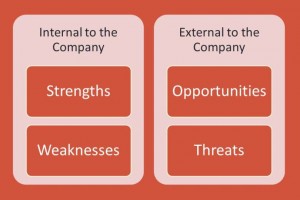Most of you who work in the corporate world would be familiar with the SWOT analysis; in fact, chances are that you would have used it often while evaluating your business, a project or a brand. Simply put, SWOT analysis is a planning method used to evaluate the strengths, weaknesses, opportunities and threats involved in a project, in a business or even a brand. What must be noted is that the strengths and weaknesses are always INTERAL factors while opportunities and threats are always EXTERNAL factors (something that the best of us don’t always understand).
In the business environment, these are the definitions for the four:
Strengths: Strengths are internal factors and characteristics of a business, a project or a brand that give it an advantage over others.
Weaknesses: Weaknesses are again internal factors and characteristics that are disadvantageous relative to others.
Opportunities: Opportunities are external factors and elements that a business could use to its advantage.
Threats: Threats are factors or elements in the environment that could cause trouble for the business.
When a business or a brand is setting its objectives, the SWOT analysis provides a reality check. A study of the SWOT will provide insights on the different objectives that you would need to set. The SWOT will also give a clear indication on whether it is possible to achieve what you have set out to do.
While the SWOT Analysis is used extensively in the business world, it can also be used effectively for one’s personal development. Some of us do try and figure out our own strengths and weaknesses but it is likely that we do it in an informal or haphazard manner. The SWOT matrix will allow us to look at things in a more structured manner. An important caveat is that one needs to be brutally honest with oneself while working on a SWOT. Missing out on important information is not going to help you develop an effective course of action. Since you don’t really have to share your personal SWOT with anyone, don’t hold your punches while working on it. Your personal SWOT will allow you to set more meaningful objectives (or goals) for yourself.
We all have one life to live; therefore, a sensible course of action is to utilise our talents to the fullest and work on eradicating our deficiencies. Similarly, there could be opportunities and threats existing in the environment and we need to exploit or tackle these on an urgent basis to move forward in our personal or professional life.
Given below are some representative questions that you need to answer while doing your own SWOT. Write them down because you will need to re-visit them frequently. Also, try and see that you see your strengths relative to people around you, especially your peers; I mean, if your peers outperform you on any particular strength, it is hardly a strength, is it?
Strengths
- What are your strengths? These could be your educational background, your special talents, your ability to speak well, your temperament, your looks.
- What are things that you do really well?
- What are your achievements that could come useful in the future?
- Do you have a good range of friends? An effective network?
- Are there any factors that give you an added advantage?
- What are your positive values and personal characteristics?
Weaknesses
- Do you have any personal traits that could be seen as weaknesses?
- Are you a procrastinator? A shirker? A gossip? A person who blames others? Any other negative work habits?
- Are there tasks that you avoid? What will the people around you see as your weaknesses?
- Are you obese? Badly dressed? Do you have poor hygiene? Are you physically unfit?
- Do you have any weaknesses in your education or your skill set? Are you a poor communicator?
Opportunities
- Are you working in a growing industry?
- Are you proficient in things that are becoming more important? For example, technology.
- Are your seniors impressed with you? Are there people who can advise and help you?
- What new technology can help you? Or can you get help from others or from people via the Internet?
- Do you have ideas that could make a difference to your company? Or business? Have you presented these to management?
- Can you provide solutions that would impress your organisation?
Threats
- Are there peers who are perceived as better than you? What do you need to do to be seen as better than them?
- Are there roadblocks in your career? Do you know how to tackle them?
- Are there friends or situations that are preventing you from doing your job better?
- Is your industry on a downward trend? Is your company in financial problems? Will it lay off people?
The above questions are only indicative and you should creatively look at all aspects while working on your SWOT.
Our personal SWOT is just the first part. The second, more important part is the setting up of your objectives (or goals). Once you have developed your SWOT, try and work out a set of personal objectives. Here are some pointers on how to do this:
- Keep your objectives to not more than seven.
- Make the objectives as specific as you can and give them a time period. For example, I will lose 15 kgs in a year. Or, I will be able to work on any kind of worksheet in Microsoft Excel within a year.
- Have some objectives that tackle your weaknesses as per the examples given above.
- Have some objectives that could exploit opportunities or handle some threats.
Once you have written down your objectives, work seriously towards achieving them. After the time you have set for your objectives is over, do a new SWOT analysis to see if things have changed for the better. Rework on your SWOT and, based on the new one, develop a NEW set of objectives for the next period.
Following this process on a continuous basis will help you develop yourself in a more systematic and highly effective manner. It would also help you do much better in your career or business.
Visual courtesy: https://www.flickr.com/photos/pustovit/








